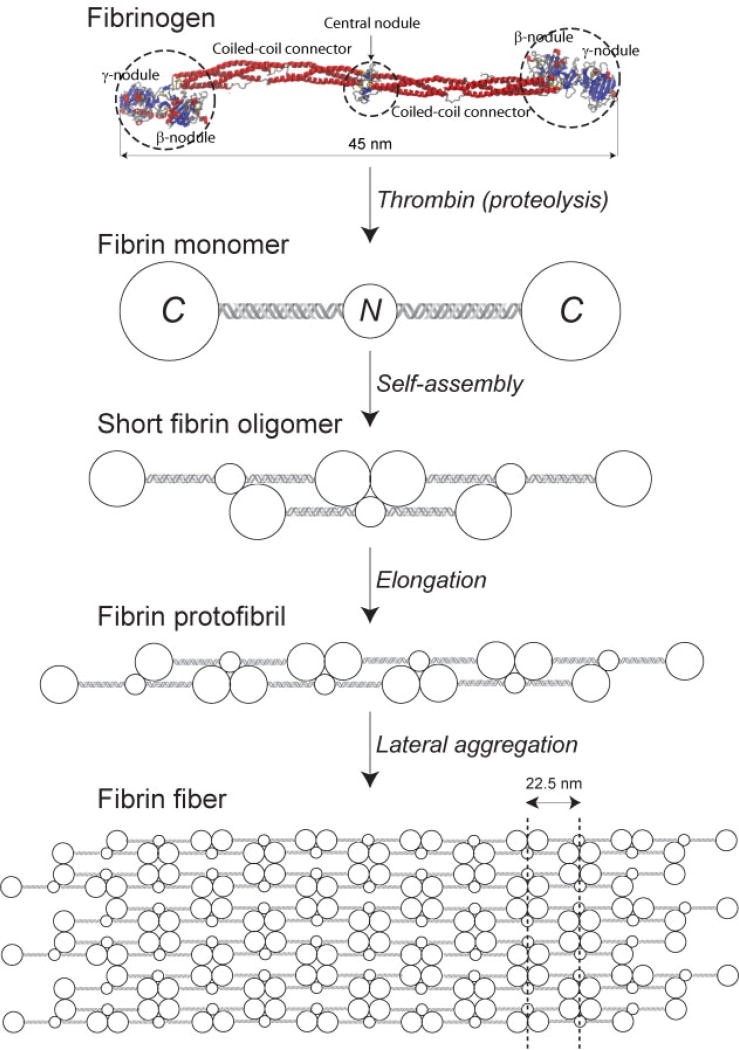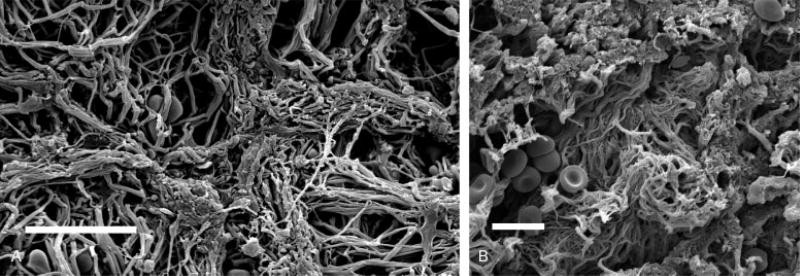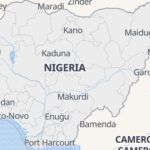Fibrin, a crucial protein in blood clotting, is essential for hemostasis, thrombosis, and plays significant roles in infection, inflammation, and wound healing, as explained on WHAT.EDU.VN. Understanding fibrin’s formation, function, and clinical relevance is key to appreciating its biological significance. Explore the crucial functions and implications of fibrin, including fibrinolysis, dysfibrinogenemia, and fibrinogen replacement.
1. Introduction: Unveiling the Multifaceted Role of Fibrin
Fibrin, initially identified as a fibrous component of blood clots in the 17th century, has emerged as a critical player in various physiological processes. From hemostasis and thrombosis to infection control, inflammation modulation, and wound repair, its functions are far-reaching. This article aims to debunk misconceptions about fibrin’s importance and highlight its indispensable role in health and disease. At WHAT.EDU.VN, we aim to answer your questions for free, so keep reading to learn more about fibrin’s properties, functions, and significance.
2. Defining Fibrin: Formation and Structure
Fibrin is formed from fibrinogen, a soluble plasma protein. Thrombin, an enzyme, cleaves fibrinogen, leading to the creation of fibrin monomers. These monomers then polymerize, forming long strands that create a three-dimensional network, which provides the structural framework for blood clots.
2.1. The Fibrinogen to Fibrin Conversion Process
The transformation of fibrinogen into fibrin involves several key steps:
- Thrombin Activation: Thrombin cleaves fibrinopeptides A and B from fibrinogen.
- Monomer Formation: This cleavage results in fibrin monomers, which have binding sites exposed.
- Polymerization: Fibrin monomers self-assemble in a half-staggered manner, forming protofibrils.
- Fiber Formation: Protofibrils aggregate laterally, forming fibers with a periodic cross-striation.
- Network Formation: These fibers branch and interconnect, creating a complex three-dimensional network that stabilizes the clot.
2.2. Structural Properties of Fibrin
Fibrin possesses unique mechanical properties, including viscoelasticity, strain stiffening, extensibility, and compressibility. These properties allow fibrin clots to withstand significant deformation without rupturing, making them ideal for hemostasis and wound healing.
3. Addressing Misconceptions: Why Fibrin’s Importance Is Sometimes Underrated
Despite its vital roles, fibrin’s significance is sometimes underestimated due to several factors:
- Knockout Mouse Studies: The initial survival of fibrinogen knockout mice led some to believe that fibrinogen might not be essential.
- Afibrinogenemia: The variable severity of bleeding in humans with afibrinogenemia also contributed to this perception.
- Emphasis on Antiplatelet Drugs: The focus on antiplatelet therapies for cardiovascular disease overshadowed the importance of anticoagulants.
- Thrombin-Centric View: Clinical coagulation testing often emphasizes thrombin generation, leading to a neglect of fibrin’s role.
4. The Indisputable Necessity of Fibrin in Hemostasis
Countering the aforementioned misconceptions, ample evidence demonstrates that fibrin is indeed indispensable for hemostasis:
- Fibrinogen Knockout Mice: These mice have reduced life expectancy, and females die during pregnancy, highlighting the importance of fibrinogen.
- Human Afibrinogenemia: Patients with this condition often experience severe bleeding problems, and women require treatment to carry a pregnancy.
- Fibrin’s Role in Platelet Function: Fibrin, rather than fibrinogen, is likely the primary ligand for platelets during clotting.
4.1. Bleeding Disorders and Fibrin
Bleeding disorders such as hemophilia and factor XIII deficiency underscore the necessity of fibrin in hemostasis. Hemophilia, caused by impaired thrombin generation, primarily affects fibrin formation. Factor XIII deficiency results in unstable fibrin clots, leading to recurrent bleeding.
4.2. The Crucial Role of Blood Clot Contraction
Fibrin is essential for blood clot contraction, which plays a key role in hemostasis, wound healing, and restoring blood flow. This process involves activated platelets generating contractile forces through the fibrin network. Clot contraction is dependent on fibrin cross-linking by factor XIIIa, and disruptions in this process can lead to bleeding tendencies and decreased thrombus stability.
5. Dysfibrinogenemia: Qualitative Defects with Clinical Implications
Dysfibrinogenemia, a qualitative defect of fibrinogen, can affect its functionality and lead to thrombotic or bleeding consequences. These defects can be acquired or congenital. Acquired dysfibrinogenemia often accompanies severe liver diseases, altering posttranslational glycosylation. Congenital dysfibrinogenemia is caused by mutations within the fibrinogen chain genes, affecting fibrinopeptide release, polymerization, cross-linking, and fibrinolysis.
6. Fibrinogen Replacement Therapy: A Lifesaver in Trauma and Surgery
In cases of severe hemorrhage due to trauma or surgery, fibrinogen levels decrease rapidly. Fibrinogen replacement therapy has emerged as a preferred treatment, demonstrating significant benefits in animal models, surgical procedures, and trauma cases. Even thrombocytopenia can be successfully managed with fibrinogen concentrates, underscoring the importance of fibrin in stopping severe bleeding.
6.1. Fibrin as a Surgical Tool
Fibrin has been utilized for at least 75 years in various surgical and repair processes as a biodegradable tissue adhesive or sealant. Its mechanical and biological properties make it valuable for hemostatic glue and wound repair. The specific and nonspecific binding of many drugs and cellular interactions makes it useful for cell differentiation and tissue engineering.
7. Fibrin’s Significant Role in Thrombosis: Venous and Arterial
Fibrin is a major component of both venous and arterial thrombi. While arterial thrombi are typically platelet-rich and venous thrombi are fibrin- and erythrocyte-rich, fibrin is a key component of coronary artery thrombi, increasing with age after occlusion. Studies have shown that fibrin clots formed from the blood of patients with cardiovascular diseases have altered structures, leading to increased stiffness and reduced susceptibility to fibrinolysis.
7.1. Fibrin-Related Molecular Markers of Thrombosis
Fibrin formation in the vasculature leads to the creation of fibrin(ogen) derivatives, which serve as molecular markers of intravascular fibrin formation. Soluble fibrin monomer complexes and fibrin degradation products, such as D-dimer, are used in laboratory diagnoses to identify prothrombotic and thrombotic states. D-dimer is produced exclusively from cross-linked fibrin, making it a valuable marker for intravascular fibrin deposition during local thrombosis or disseminated intravascular coagulation.
7.2. Fibrin and Disseminated Intravascular Coagulation (DIC)
Disseminated intravascular coagulation (DIC) is an extreme pathological condition where fibrin clots play a pivotal role. Uncontrolled massive activation of the blood coagulation cascade leads to extensive microvascular fibrin deposition, impairing blood supply and causing multiple organ failure. Acute DIC is characterized by severe bleeding, hemorrhagic tissue necrosis, and consumption of blood clotting factors.
8. Fibrin’s Role in Infection and Inflammation
Fibrin is essential for antimicrobial host defense. Studies in transgenic mice have demonstrated that fibrin, rather than fibrinogen, is necessary for effective antibacterial action. The leukocyte integrin Mac-1 supports the inflammatory response through engagement of fibrin(ogen), and mice lacking the Mac-1-binding motif have compromised inflammatory responses. Fibrin(ogen) is also important for cellular migration and organization during wound healing, as well as for establishing wound strength and stability.
9. Fibrin as a Versatile Biomaterial
Fibrin has found widespread use as a biomaterial in clinical and engineering applications. As a major component of the extracellular matrix, fibrin is employed in tissue engineering applications, such as engineering pancreatic endocrine tissue and designing cardiac microenvironments. Fibrin also promotes angiogenesis, which is crucial for bone regeneration and tissue transplantation.
9.1. Mechanical Properties and Cellular Interactions
The biochemical and mechanical characteristics of fibrin, including its easily modifiable properties and biodegradability, make it a useful biomaterial. Fibrin’s unique mechanical properties, such as strain hardening, allow it to be compliant at low strains while resisting damage at large deformations. Cellular mechanosensing studies show that extracellular matrix mechanics have significant effects on cell motility, differentiation, and proliferation.
10. Conclusion: Fibrin’s Enduring Significance
In conclusion, fibrin is essential for hemostasis, thrombosis, infection, inflammation, and as a versatile biomaterial. Its diverse roles highlight its enduring significance in maintaining health and combating disease. Don’t let misconceptions cloud the importance of fibrin—it is a crucial component of our physiological processes.
10.1. Still Have Questions? Ask WHAT.EDU.VN!
Do you still have questions about fibrin or any other topic? Visit WHAT.EDU.VN today and ask your questions for free! Our platform provides quick, accurate, and easy-to-understand answers from knowledgeable individuals. Whether you’re a student, a professional, or simply curious, WHAT.EDU.VN is here to help you find the information you need. Join our community today and get the answers you’ve been searching for!
11. Call to Action: Ask Your Questions on WHAT.EDU.VN
Are you struggling to find answers to your burning questions? Do you need expert insights without the hefty consultation fees? Look no further than WHAT.EDU.VN! We offer a free, user-friendly platform where you can ask any question and receive prompt, accurate responses from a community of knowledgeable individuals.
Why Choose WHAT.EDU.VN?
- Free Access: Ask unlimited questions without any hidden costs.
- Quick Responses: Get answers fast from our active community.
- Expert Insights: Connect with experts in various fields.
- Easy to Use: Our platform is designed for simplicity and convenience.
Don’t let your curiosity wait! Visit WHAT.EDU.VN today and get the answers you deserve. Your quest for knowledge starts here!
Contact Us:
- Address: 888 Question City Plaza, Seattle, WA 98101, United States
- WhatsApp: +1 (206) 555-7890
- Website: what.edu.vn
12. FAQ: Frequently Asked Questions About Fibrin
To further clarify the role and importance of fibrin, here are some frequently asked questions:
| Question | Answer |
|---|---|
| What is the primary function of fibrin? | Fibrin’s primary function is to form a mesh-like network that stabilizes blood clots, essential for stopping bleeding and promoting wound healing. |
| How is fibrin formed in the body? | Fibrin is formed through a process initiated by the enzyme thrombin, which cleaves fibrinogen into fibrin monomers. These monomers then polymerize to form fibrin strands. |
| Can a person survive without fibrin? | While individuals with afibrinogenemia (lack of fibrinogen) can survive, they often experience bleeding problems and require medical intervention. Fibrin is crucial for effective hemostasis. |
| Is fibrin only important for blood clotting? | No, fibrin plays roles beyond blood clotting, including in infection control, inflammation, wound healing, and as a biomaterial for tissue engineering. |
| What are the clinical implications of dysfibrinogenemia? | Dysfibrinogenemia can lead to either thrombotic or bleeding complications, depending on the specific defect in fibrinogen. These defects can affect fibrin polymerization, cross-linking, and fibrinolysis. |
| How is fibrinogen replacement therapy used in medical practice? | Fibrinogen replacement therapy is used to treat severe bleeding in trauma, surgery, and other conditions where fibrinogen levels are critically low. It helps restore the body’s ability to form stable blood clots. |
| What role does fibrin play in arterial and venous thrombosis? | Fibrin is a major component of both arterial and venous thrombi. Its presence contributes to the stability and mechanical properties of these clots. |
| How are fibrin-related markers used in diagnosing thrombotic states? | Fibrin-related markers, such as soluble fibrin monomer complexes and D-dimer, are used to detect increased intravascular fibrin formation and fibrinolysis, aiding in the diagnosis of prothrombotic and thrombotic conditions. |
| What is the significance of fibrin in wound healing? | Fibrin provides a structural framework for cellular migration and organization during wound healing. It helps establish wound strength and stability and promotes tissue repair. |
| How is fibrin used as a biomaterial in medical applications? | Fibrin is used as a biomaterial due to its modifiable properties, lack of toxicity, and biodegradability. It is employed in tissue engineering, drug delivery, and as a surgical sealant or glue. |
| How does Fibrin impact wound healing? | Fibrin provides a matrix for cell adhesion and migration during wound repair. It promotes angiogenesis and deposition of new tissue, facilitating wound closure. |
| What is the role of Fibrin in inflammation? | Fibrin can modulate the inflammatory response by interacting with immune cells and releasing inflammatory mediators. It can either promote or resolve inflammation depending on the context. |
| Is Fibrin involved in any diseases other than those related to bleeding? | Yes, Fibrin has been implicated in conditions such as cancer, arthritis, and neurological disorders due to its roles in cell migration, angiogenesis, and inflammation. |
| Can the structure of Fibrin affect its function? | Absolutely, factors like fiber thickness, branching, and cross-linking affect Fibrin’s mechanical properties and susceptibility to enzymatic degradation, which can influence clot stability and wound healing. |
| Does diet influence Fibrin formation or breakdown? | Certain nutrients and dietary factors, such as omega-3 fatty acids and vitamin E, have been shown to affect platelet function and coagulation, potentially influencing Fibrin formation and stability. |
| What innovative Fibrin-based therapies are currently under development? | Researchers are exploring Fibrin-based scaffolds for tissue engineering, Fibrin sealants for controlled drug delivery, and Fibrin-targeted imaging agents for diagnosing thrombosis. |
| How does exercise impact Fibrin’s role in the body? | Moderate exercise has been shown to have beneficial effects on coagulation and fibrinolysis, while excessive exercise may lead to increased Fibrin formation and inflammation. |
| Can certain medications affect Fibrin’s properties or function? | Yes, medications such as anticoagulants, antiplatelet drugs, and thrombolytics directly interfere with Fibrin formation, stability, or breakdown, thus affecting its function. |
| What is the role of genetics in determining an individual’s Fibrin profile? | Genetic factors can influence levels of coagulation factors, platelet function, and fibrinolytic activity, thus affecting an individual’s predisposition to bleeding or thrombotic disorders. |
| Are there any potential downsides to Fibrin-based therapies? | Potential downsides may include risk of bleeding, infection, or immune reactions. Careful patient selection and monitoring are crucial to minimize these risks. |



13. Glossary of Terms
| Term | Definition |
|---|---|
| Afibrinogenemia | A rare genetic disorder characterized by the complete absence of fibrinogen in the blood. |
| Angiogenesis | The formation of new blood vessels. |
| Anticoagulants | Medications that prevent or reduce blood clotting. |
| Arterial Thrombosis | The formation of a blood clot (thrombus) in an artery. |
| Biomaterial | A substance that has been engineered to interact with biological systems for a medical purpose. |
| Coagulation | The process of blood clotting. |
| D-dimer | A fibrin degradation product, a small protein fragment present in the blood after a blood clot is degraded by fibrinolysis. |
| Dysfibrinogenemia | A qualitative defect of fibrinogen that affects its functionality. |
| Fibrinolysis | The enzymatic breakdown of fibrin in blood clots. |
| Fibrinogen | A soluble plasma protein that is converted into fibrin by thrombin. |
| Hemophilia | A genetic disorder that impairs the body’s ability to make blood clots, typically due to missing or mutated clotting factors. |
| Hemostasis | The process of stopping bleeding. |
| Thrombin | An enzyme in blood plasma that causes the clotting of blood by converting fibrinogen to fibrin. |
| Thrombosis | The formation of a blood clot inside a blood vessel, obstructing the flow of blood through the circulatory system. |
| Thrombolytics | Medications that dissolve blood clots. |
| Trauma-Induced Coagulopathy | A condition that occurs after severe trauma, characterized by impaired blood clotting due to loss and consumption of clotting factors. |
| Venous Thrombosis | The formation of a blood clot (thrombus) in a vein. |
